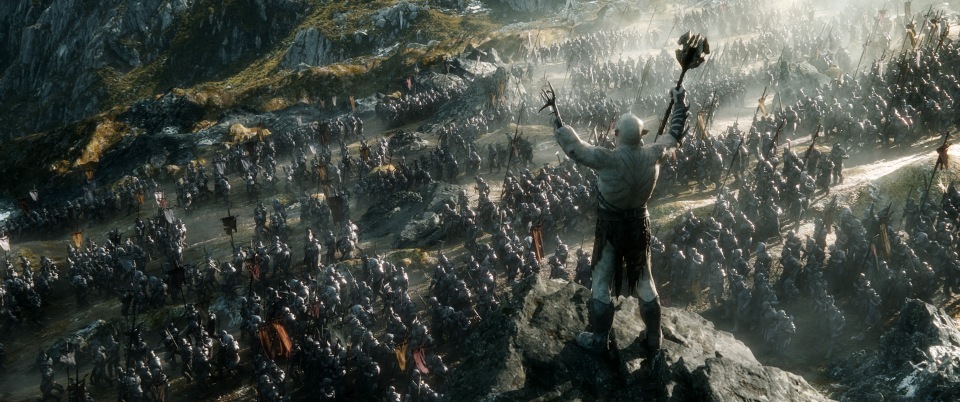In the last of Peter Jackson’s J.R.R. Tolkien adaptations—we hope, anyway!—erstwhile Shire-dweller Bilbo Baggins (Martin Freeman) and his dwarven allies (Richard Armitage and a bunch of guys who don’t get any lines) defend the Lonely Mountain from elves, orcs and hungry fishermen.
Ryan: When we reviewed last year’s The Desolation of Smaug—the predecessor to The Battle of the Five Armies—I mentioned how difficult it was to give it a full appraisal until we had a chance to see the Hobbit trilogy’s conclusion. Desolation felt unfinished and ended in an unsatisfying cliffhanger. By picking up after that cliffhanger and bringing the story to its conclusion, Battle enables us to determine once and for all whether the creative decisions governing this entire series were well-founded.
So, is The Battle of the Five Armies able to right the ship? I’m assuming that’s what you want to know … I can’t hear you all that well because I’m on the ship, and the ship is now underwater.
Don’t misunderstand. This isn’t a total catastrophe. Battle has some degree of entertainment to offer, albeit even less than The Desolation of Smaug. Some of the action sequences are entertaining, if not entirely clever or possessing the epic feel of Jackson’s earlier work in this franchise. And while actors like Martin Freeman, Ian McKellan and Lee Pace can’t save this thing by force of will, their charm and consistency provides a welcome reprieve from all the sturm und drang surrounding them.
Everything in Battle, more than either of the previous Hobbit movies, feels like a thinner, weaker version of the vastly superior Lord of the Rings series. You have a slow buildup to an epic land battle; you have orcs on the move, and elves joining the fray when they are least expected. Bard (Luke Evans), a reluctant leader of men, looks and sounds a whole lot like Aragorn. Tearful goodbyes to dying comrades, wizard battles, eagles out of freaking nowhere, Legolas … it’s all here. But it’s also all worse than before—fight scenes drag on far too long, and most character beats lack any emotional punch.
Instead of the careful character work present in LOTR—as well as An Unexpected Journey, which I still think is really good—we get lots and lots of filler, more than the first two Hobbit films combined. That’s what happens when the majority of your film covers an event during which the point-of-view character in the source material is unconscious.
The difference in quality between elements taken from the book and those synthesized from the appendices in The Lord of the Rings (detailing events leading up to Sauron’s return that took place parallel to The Hobbit) is significant. It was significant in the earlier installments as well, but there’s so much more chaff this time around. I mean, it’s almost as if there wasn’t enough here to fill three movies! Imagine that. Here, at the end of all things (see what I did there?!?), can we agree once and for all that there was no creative justification for making three films out of a 300-page novel?
Rebecca: Why, yes, I think we can.
While the first two Hobbit films at least hinted at an awareness of the source material—that The Hobbit, unlike the Lord of the Rings series, is more children’s morality tale than unwieldy epic—this final film chucks all the fun of the episodic novel and Bilbo’s charm out the window in favor of boring battle sequences, some psychedelic dwarf brooding, and unneeded foreshadowing of the bleak story to come in The Lord of the Rings.
It’s a cynical question, and I’m not the only one asking it, but could it be the filmmakers are trying to hook a new generation on the older films to rev up DVD sales? Could this move towards the tone of LOTR indicate some effort to achieve commercial continuity?
Regardless of the reason, in The Battle of the Five Armies, Martin Freeman’s delightful Bilbo gets lost in the chaos, revealing just how far the filmmakers have strayed from what is meant to be, ultimately, one character’s story. (Your point that he is unconscious for the duration of the battle in the book is right on.)
Even the love-triangle subplot introduced in the last film, which many critics praised for its creativity in pairing Evangeline Lilly’s elf warrior with the hottest dwarf around, falls flat. With yearning slow-mo shots, the camera tells us to feel things, that this doomed romance has Romeo and Juliet-style emotional heft. This, after the script has contributed maybe four scenes of development to their relationship. For that matter, scenes throughout are book-ended by cheesy close-up shots of actors in wigs staring intensely and grimacing, a technique best known for its use on soap-operas to denote a pause before a commercial break.
Sure, none of these failures are Razzie-level egregious, but considering the excellence of the original series, this last film is especially disappointing—it proves that while Peter Jackson and company might still know how to stage a battle amid a CGI-enhanced New Zealand vista, they’ve lost their touch for storytelling.
